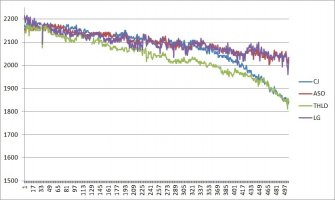505 Cycles!!!! (Actually, I just finished Cycle 535, but I just got the time to post this now).
Here are the results:


And the degradation:

One thing that these capacity tests do not show is IR. Even though the LG cell is doing pretty well, it definitely has the highest IR. It takes the longest to charge, and it has the highest "bounce" voltage on the first test in the morning. The THLD cell, though it lost a lot of capacity, still has the tightest voltage and is the fastest to charge. I could literally do 4 tests a day if it was only the THLD cell, but the LG cell is slowing me down. It's getting to the point that I have like a half-hour window to take a picture of the third result of the day between when the THLD cell is fully charged after its third cycle and the LG cell finishes discharging its third cycle.
Androfire - I was hoping to use a Samsung, since they seem to have the highest respect, but the ones I had were too low in capacity and I didn't want it to look like I used a bad Genuine cell to inflate the performance of the Generics. So I had to use the LG - it was the best capacity 2200mAh genuine cell that I have. Ideally, I would have started with a brand new cell, but I never thought I would get to 500+ cycles, so here I am.
AcE Krystal - Well, I am fully charging and discharging these cells, so I don't have any hard data on limiting voltage ranges to prolong life. That kind of test takes a lot of time and sensitive equipment, neither of which I have.
eas - Actually, I do believe self-discharge rate and cycle-age are correlated. When I look at my genuine cells, the cells that self discharge more usually have less capacity. There are of course damaged cells that have great capacity and self-discharge a lot, but in general, cells that are near full capacity will still be at 4.18V after 6 months, while the ones that only have 70% will be around 4.12V after 6 months. Also, don't get me wrong, there is still a lot of Chinese junk out there. But it seems that even in 2011 when these cells were produced, some Chinese manufacturers were already producing decent quality cells. I guess it's like Honda/Toyota in the 80s or Hyundai in the 2000s got a bad wrap for producing junk, and it took some time until those cars became mainstream. I was also considering switching slots every cycle and rotating the cells randomly, but didn't for 2 reasons - (1) I hand wrote capacities and later transferred to a computer; it was easier to keep track of the cells and their capacities every 25 cycles than every cycle; and (2) I didn't rotate the cells in order to keep the cell's label on every picture I took. With the personality I have, I don't really trust anyone I don't know, and I always am second guessing their motivation for giving me information. Usually if someone is trying tosell me something, I assume the opposite of what they say must be true. Anyway, by keeping the cells label-up for the pictures I took of every cycle, I wouldn't have someone telling me the test is fake because I was switching out cells for new ones all the time to inflate the generic cell's results. Paranoid? Maybe. I guess you could photoshop results, too. Anything can be photoshopped, but now that would be paranoid. Yes, part of the jaggedness would be temperature variations. But also, internal resistance, the Opus' margin of error, and how long the cell was charged from the previous cycle all play a part. Again, if I were publishing a scientific paper on this, or selling these cells to a large buyer, you bet I would be doing all you mentioned, as well as Thunderheart, Oz18650, and the rest. All very good suggestions on making this test 100% accurate and reliable. I was just going for good enough for our community while minimizing the shortcomings. People are free to treat my test as inaccurate, and I welcome literally anyone else to do this test over with better equipment and publish the results for everyone free of charge.
Oz18650 - This test was performed by me in my home. The coldest it would get in my home would be 70*F in winter and in the summer maybe 82*F in the afternoon. But that would be minimum and maximum. Most of the time my home is between 74*F and 76*F. I also never test overnight for obvious reasons, not that it would matter much indoors. I agree that temperature matters a lot - look at my post about Cycle 35 where I just ran a 120mm computer fan over the cells. There was a 3-4% decrease in capacities for that cycle.








